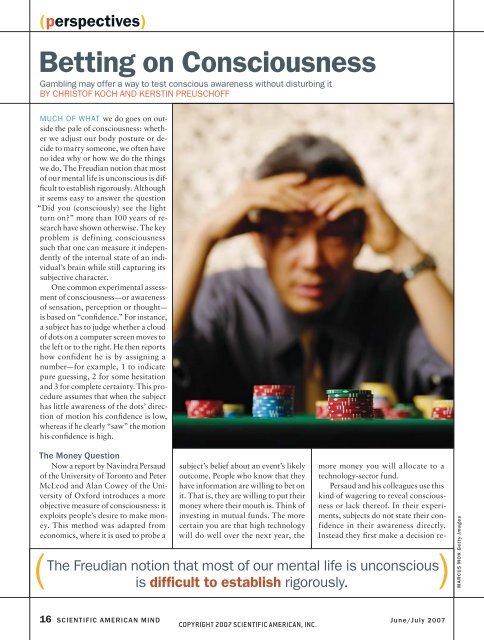Scientific American Mind-June/July 2007
Scientific American Mind-June/July 2007
Scientific American Mind-June/July 2007
You also want an ePaper? Increase the reach of your titles
YUMPU automatically turns print PDFs into web optimized ePapers that Google loves.
(perspectives)<br />
Betting on Consciousness<br />
Gambling may offer a way to test conscious awareness without disturbing it<br />
BY CHRISTOF KOCH AND KERSTIN PREUSCHOFF<br />
MUCH OF WHAT we do goes on outside<br />
the pale of consciousness: whether<br />
we adjust our body posture or decide<br />
to marry someone, we often have<br />
no idea why or how we do the things<br />
we do. The Freudian notion that most<br />
of our mental life is unconscious is diffi<br />
cult to establish rigorously. Although<br />
it seems easy to answer the question<br />
“Did you (consciously) see the light<br />
turn on?” more than 100 years of research<br />
have shown otherwise. The key<br />
problem is defining consciousness<br />
such that one can measure it independently<br />
of the internal state of an individual’s<br />
brain while still capturing its<br />
subjective character.<br />
One common experimental assessment<br />
of consciousness—or awareness<br />
of sensation, perception or thought—<br />
is based on “confi dence.” For instance,<br />
a subject has to judge whether a cloud<br />
of dots on a computer screen moves to<br />
the left or to the right. He then reports<br />
how confident he is by assigning a<br />
number—for example, 1 to indicate<br />
pure guessing, 2 for some hesitation<br />
and 3 for complete certainty. This procedure<br />
assumes that when the subject<br />
has little awareness of the dots’ direction<br />
of motion his confi dence is low,<br />
whereas if he clearly “saw” the motion<br />
his confi dence is high.<br />
The Money Question<br />
Now a report by Navindra Persaud<br />
of the University of Toronto and Peter<br />
McLeod and Alan Cowey of the University<br />
of Oxford introduces a more<br />
objective measure of consciousness: it<br />
exploits people’s desire to make money.<br />
This method was adapted from<br />
economics, where it is used to probe a<br />
subject’s belief about an event’s likely<br />
outcome. People who know that they<br />
have information are willing to bet on<br />
it. That is, they are willing to put their<br />
money where their mouth is. Think of<br />
investing in mutual funds. The more<br />
certain you are that high technology<br />
will do well over the next year, the<br />
more money you will allocate to a<br />
technology-sector fund.<br />
Persaud and his colleagues use this<br />
kind of wagering to reveal consciousness<br />
or lack thereof. In their experiments,<br />
subjects do not state their confidence<br />
in their awareness directly.<br />
Instead they fi rst make a decision re-<br />
( The Freudian notion that most of our mental life is unconscious )<br />
is diffi cult to establish rigorously.<br />
16 SCIENTIFIC AMERICAN MIND <strong>June</strong>/<strong>July</strong> <strong>2007</strong><br />
COPYRIGHT <strong>2007</strong> SCIENTIFIC AMERICAN, INC.<br />
MARCUS MOK Getty Images

















